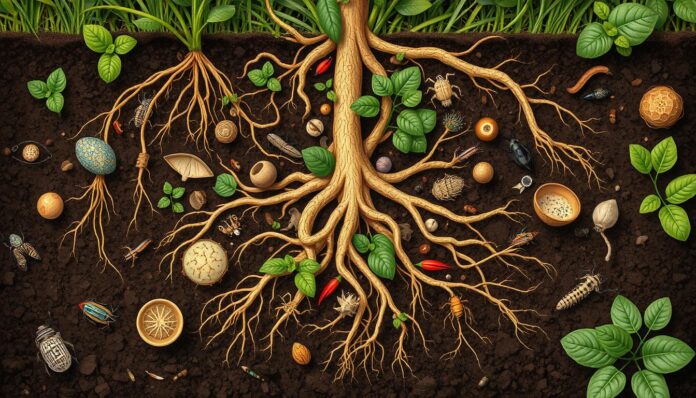What if the secret to sustainable farming is in the soil food web? Permaculture soil food web principles can help create a thriving ecosystem. A healthy soil ecosystem is key for sustainable farming. It can be achieved with compost, cover crops, and other regenerative practices.
By using a permaculture approach to soil management, farmers and gardeners can boost soil fertility. They can also cut down on water use and increase crop yields. This helps in making farming more sustainable.
Creating proper soil structure can save up to 30-60% of water. Understanding soil biology is crucial in managing the permaculture soil food web. The soil cycle starts with high bacterial content, then moves to a fungal-dominant state.
It’s vital to know the importance of soil foodweb structure for ecosystem health. By improving soil health through permaculture, we can lessen the need for chemical fertilizers. This leads to a more sustainable food system.
Key Takeaways
- Permaculture soil food web principles can help create a thriving ecosystem
- Healthy soil ecosystem is essential for sustainable agriculture
- Compost, cover crops, and regenerative practices can improve soil fertility and reduce water consumption
- Understanding soil biology and structure can lead to significant water savings
- Permaculture approach to soil management can increase crop yields and contribute to sustainable agriculture
- Soil foodweb structure is a prime indicator of ecosystem health
- Reducing chemical fertilizer use can create a more sustainable food system through permaculture soil food web management
Understanding the Soil Food Web in Permaculture
The soil food web is a complex network of organisms. They work together to create a thriving ecosystem. This ecosystem is key for plant growth and overall health.
In organic gardening, the soil food web is vital. It helps maintain ecosystem diversity and promotes beneficial microorganisms.
A healthy soil food web needs a variety of organisms. These include bacteria, fungi, and protozoa. They break down organic matter, recycle nutrients, and control pests and diseases.
By creating a balanced ecosystem, organic gardening supports ecosystem diversity. It also helps the growth of beneficial microorganisms.
https://www.youtube.com/watch?v=iiAcmdoPft0
As noted in the article The Soil Food Web: A Permaculture, a diverse and complete soil food web is essential for maintaining soil health. This can be achieved through the use of organic gardening practices, such as adding organic matter and minimizing soil disturbance.
Some key strategies for promoting a healthy soil food web include:
- Adding organic matter, such as compost or mulch, to the soil
- Minimizing soil disturbance, such as through no-till or reduced-till gardening
- Using cover crops to promote soil health and biodiversity
By following these strategies and promoting ecosystem diversity, organic gardeners can create a thriving soil food web. This supports the growth of healthy plants and beneficial microorganisms.
| Organic Gardening Practice | Benefit to Soil Food Web |
|---|---|
| Adding organic matter | Provides food for beneficial microorganisms |
| Minimizing soil disturbance | Reduces disruption to soil ecosystem |
| Using cover crops | Promotes soil health and biodiversity |
Key Organisms in the Soil Food Web
Soil is teeming with life, hosting over 50 million types of bacteria and fungi. These tiny creatures are vital for soil health. They thrive thanks to regenerative farming and composting.
Soil has all the nutrients plants need, but they’re often hard to get. This is where the soil’s tiny workers come in. They help unlock these nutrients for plants to use.
Bacteria and Their Roles
Bacteria are everywhere in the soil, with millions in every acre. They break down organic matter and make nutrients available to plants.
Fungi: The Network Builders
Fungi, with over 3,000 species, create networks in the soil. These networks help plants and microbes share nutrients. This is key for soil health and plant growth.
Protozoa and Nematodes
Protozoa and nematodes help control diseases and move nutrients around. They’re important for the soil’s balance. Their work is boosted by composting and regenerative farming.
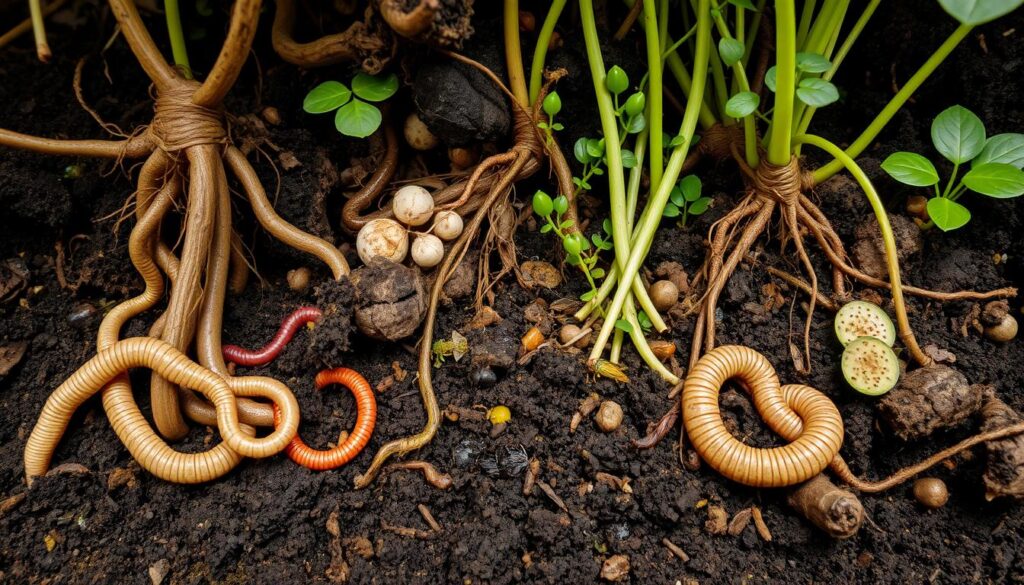
By understanding and supporting these organisms, we can improve soil health. This leads to a more sustainable and productive environment.
| Organism | Role in Soil Food Web |
|---|---|
| Bacteria | Decompose organic matter, release nutrients |
| Fungi | Form networks for nutrient exchange |
| Protozoa and Nematodes | Control diseases, cycle nutrients |
How Soil Health Influences Plant Growth
Soil health is key for plant growth. It gives plants the nutrients and water they need to do well. In sustainable farming, keeping the soil diverse is vital. This diversity helps create a strong soil food web.
A healthy soil food web has many microorganisms. These include bacteria, fungi, and protozoa. They work together to break down organic matter and make nutrients for plants.
The soil food web is crucial for soil health. It’s essential for sustainable farming. By keeping the soil diverse, farmers can make a balanced and strong soil ecosystem. This ecosystem supports plant growth and cuts down on the need for outside help.
Some ways to improve soil health include:
- Adding organic matter, like compost or manure, to the soil to give nutrients and improve its structure
- Using cover crops to reduce soil erosion and help the soil biota
- Minimizing soil disturbance to keep the soil structure and help it hold water
Nutrient Availability
Nutrient availability is key for plant growth. It’s influenced by the soil food web. In a healthy soil, microorganisms break down organic matter and make nutrients for plants.
This process is vital for sustainable farming. It cuts down on the need for outside help and promotes diversity in the ecosystem.
Water Retention and Soil Structure
Water retention and soil structure are also important for plant growth. They’re influenced by the soil food web. In a healthy soil, microorganisms help improve the soil structure and keep water in the soil.
This reduces the need for irrigation and cuts down on soil erosion. By promoting diversity and keeping the soil food web healthy, farmers can create a strong and sustainable soil ecosystem. This ecosystem supports plant growth and reduces the need for outside help.
| Soil Health Indicator | Importance for Plant Growth |
|---|---|
| Nutrient availability | Essential for plant growth and development |
| Water retention | Critical for reducing soil erosion and promoting plant growth |
| Soil structure | Influences water retention and nutrient availability |
The Role of Organic Matter
Organic matter is key to healthy soil and regenerative farming. It feeds soil organisms, keeping the ecosystem balanced. In organic gardening, composting makes soil rich in nutrients, helping plants grow.
Leaves, plant residues, and compost are good sources of organic matter. They are full of nutrients that help beneficial microorganisms in the soil. By adding organic matter, farmers can use less synthetic fertilizers and farm more sustainably.
Benefits for Soil Organisms
Organic matter is great for soil organisms. It gives them food, helping them grow and be active. This supports a balanced ecosystem and healthy plants. The benefits include:
- Increased nutrient availability
- Improved soil structure
- Enhanced microbial activity
By composting and adding organic matter, farmers support regenerative farming. This method helps plants grow well. It also makes food healthier and more nutritious for us.
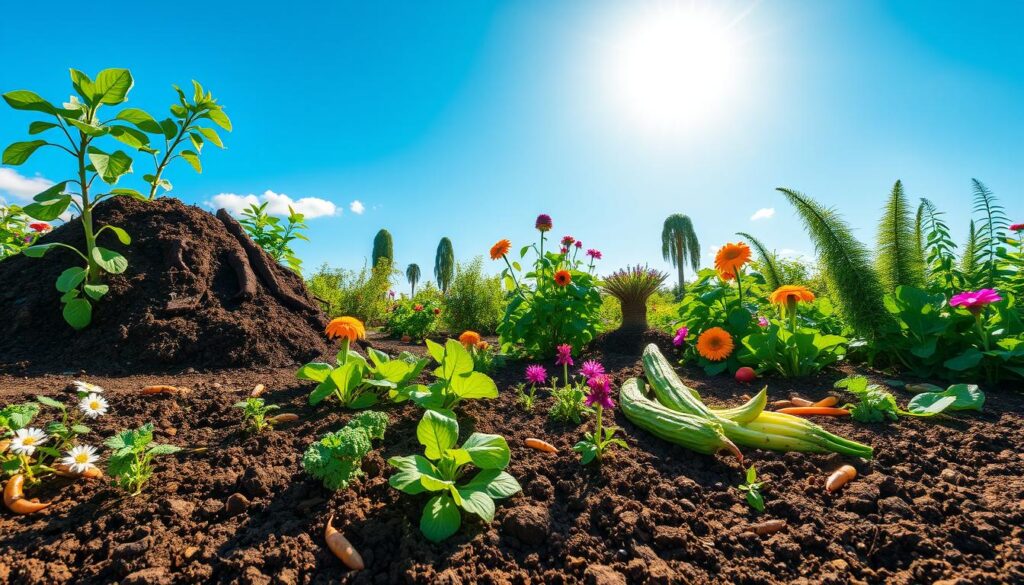
| Source of Organic Matter | Benefits |
|---|---|
| Compost | Rich in nutrients, supports microbial growth |
| Decomposing leaves | Provides food for soil organisms, improves soil structure |
| Plant residues | Supports growth of beneficial microorganisms, increases nutrient availability |
Permaculture Principles Applied to Soil Health
Permaculture is a way to grow food that’s good for the planet. It focuses on having many different types of life in the soil. Dr. Elaine Ingham’s Soil Food Web Approach is a big part of this. It teaches us to watch and work with the soil.
Some important ways to use permaculture for better soil include:
- Watching and working with the soil to learn about it
- Using things like leaves and grass clippings to help the soil
- Designing in a way that makes the ecosystem strong and varied
By doing these things, we can make a soil food web that helps plants grow. This is good for the planet and for us. For more info on permaculture, check out permaculture resources. Sustainable agriculture is a big part of permaculture. It helps us make a healthy place for plants and people.
Permaculture works for all kinds of soil. By using natural materials and designing smartly, we can make a strong and varied ecosystem. This way of farming is good for the environment and for us.
| Permaculture Principle | Application to Soil Health |
|---|---|
| Observe and interact | Understand soil ecosystem characteristics |
| Use renewable resources | Promote soil health with natural materials |
| Stack functions in design | Create a diverse and resilient ecosystem |
Building Soil Food Webs Through Diversity
Regenerative farming, like organic gardening, is key to building soil food webs. It promotes soil diversity, supporting beneficial microorganisms. Dr. Elaine Ingham has spent her career studying the soil food web’s role in ecosystems.
Crop rotation and plant diversity are vital. They create a diverse soil ecosystem. This supports many beneficial microorganisms. Companion planting, like pairing marigolds with tomatoes, also helps. It can deter pests and improve soil health.
Crop Rotation and Plant Diversity
Crop rotation and plant diversity are crucial. They break disease and pest cycles. They also improve soil structure and fertility. Organic gardening practices like composting and mulching enhance these benefits.
- Improved soil health and fertility
- Increased crop yields and quality
- Reduced disease and pest pressure
- Enhanced biodiversity and ecosystem services
Companion Planting Strategies
Companion planting pairs plants for mutual benefit. It improves soil health and deters pests. For example, marigolds with tomatoes and beans with corn are good pairings.
| Plant | Companion Plant | Benefit |
|---|---|---|
| Tomatoes | Marigolds | Deters nematodes |
| Corn | Beans | Provides shade and improves soil health |
| Cucumbers | Dill | Improves growth and flavor |
The Benefits of Mulching
Mulching is a simple yet effective way to improve soil health. It helps create a healthy soil food web in permaculture. Mulch keeps moisture in, stops weeds, and controls soil temperature. This makes it perfect for plants to grow well.
Using composting with mulching makes soil even more nutrient-rich. A permaculture soil food web needs microorganisms, plants, and soil to work together. Mulching adds organic matter, which microorganisms break down. This makes nutrients available to plants.
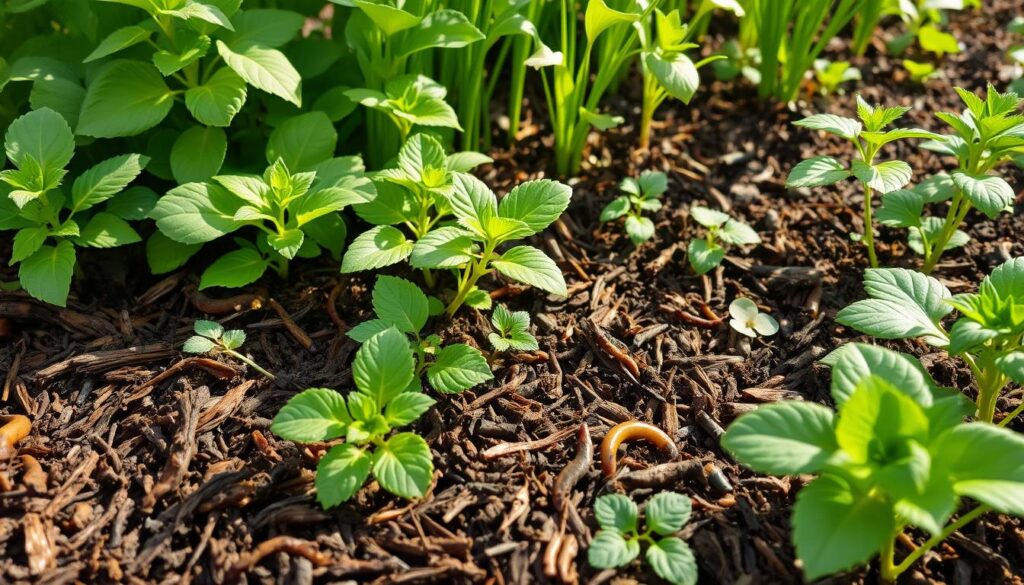
- Reduced watering needs by up to 50%
- Improved soil moisture retention
- Suppressed weed growth
- Regulated soil temperature
Mulching in permaculture helps create a sustainable ecosystem. It supports soil health and plant growth.
Composting: Enhancing the Soil Food Web
Composting is key in organic gardening and regenerative farming. It boosts the soil food web by adding vital nutrients to soil life. The health of your food depends on the soil it grows in. So, composting is crucial for keeping soil fertile.
To make good compost, knowing the carbon-to-nitrogen ratio is important. Sawdust is high in carbon, while fish or chicken manure is high in nitrogen. You need a mix of “green” and “brown” materials for the best ratio of 25-30 parts carbon to 1 part nitrogen.
Here are some examples of materials and their carbon-to-nitrogen ratios:
- Sawdust: 500:1
- Fish: 7:1
- Chicken manure: 12:1
By mixing these materials correctly, you can make compost rich in nutrients. This supports the growth of good microorganisms in the soil. It helps improve the soil food web and promotes healthy plant growth in your garden or farm.
Soil Testing and Analysis
Soil testing is key to understanding soil health and composition. It’s vital for a thriving permaculture soil food web. By analyzing the soil, farmers and gardeners can find the right nutrient levels, pH, and organic matter. This helps them make smart choices about fertilizers and other practices.
A healthy soil food web has a good balance of fungi and bacteria. This balance can mean less need for extra plant nutrients. Soil testing shows where the balance is off, helping to fix it and support sustainable farming.
When testing soil, consider these important factors:
- Soil pH level, aiming for above 5.3 (water) or 4.5 (CaCl2)
- Organic matter levels, aiming for above 2%
- Nutrient availability, like nitrogen, phosphorus, and potassium
Soil testing and analysis help farmers and gardeners build a sustainable permaculture system. It promotes soil health and cuts down on the need for outside help. This is crucial for keeping the soil healthy and supporting plant growth over time.
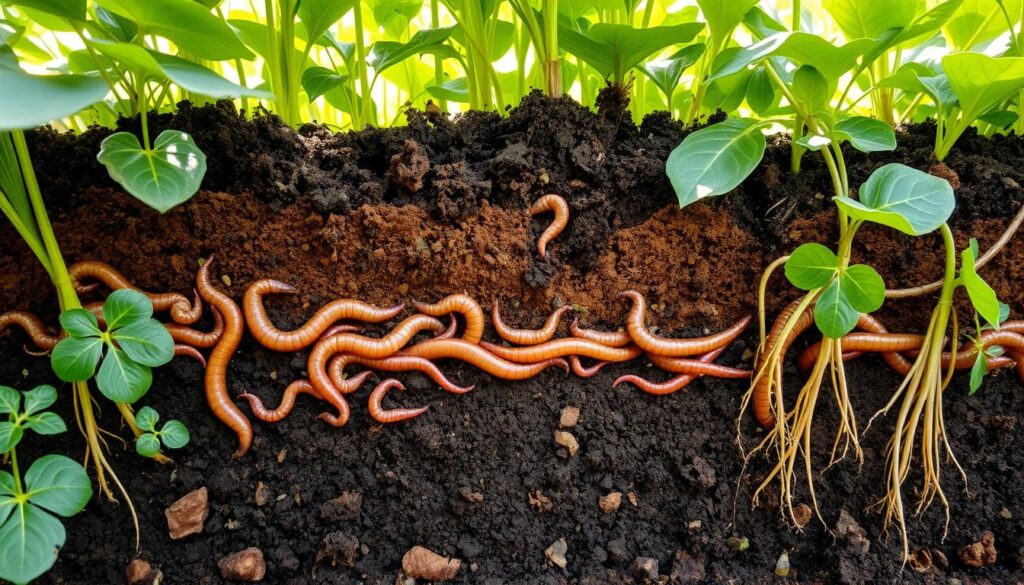
| Soil Component | Ideal Percentage |
|---|---|
| Mineral particles | 45% |
| Organic matter | 5% |
| Water | 25% |
| Air | 25% |
Managing Soil Moisture
Soil moisture is key in regenerative farming and organic gardening. It affects how diverse our ecosystems are. To keep soil healthy, we need to manage its moisture well. In regenerative farming, we use mulching and cover cropping to keep the soil moist.
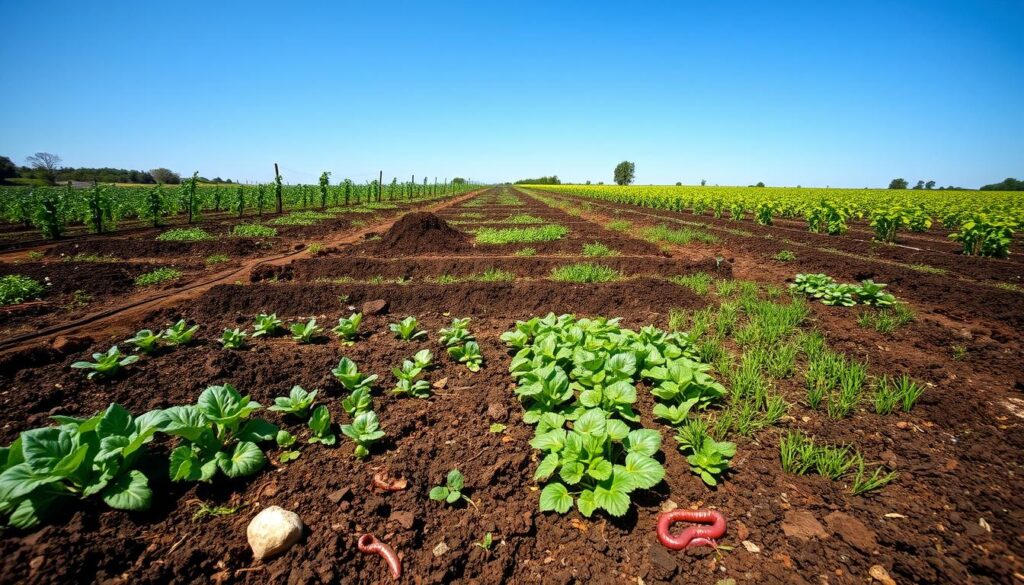
Techniques for Moisture Retention
Using deep, diverse mulches and planting many crops together are good ways to keep soil moist. These methods also boost soil nitrogen and add to biodiversity. Plus, earthworks and low-till gardening help keep the soil stable and improve water flow.
Impact of Water on Soil Organisms
Water is vital for the soil’s food web, impacting soil organisms’ health. In organic gardening, keeping the right moisture level is crucial for microorganisms. By using holistic methods like vermicomposting and rotational grazing, we can keep the soil moist and support diverse ecosystems.
| Technique | Benefits |
|---|---|
| Mulching | Retains moisture, increases soil nitrogen, and enhances biodiversity |
| Polyculture interplantings | Increases soil nitrogen, promotes ecosystem diversity, and supports beneficial microorganisms |
| Infiltration earthworks | Stabilizes soil systems, promotes water cycling, and supports regenerative farming practices |
Avoiding Soil Disturbance
Keeping the soil undisturbed is key for a healthy permaculture soil food web. Soil disturbances, like overworking, harm the soil structure and food web. This affects the ecosystem’s health.
To avoid this, try no-till gardening. Excessive tilling can kill earthworms and microorganisms. This makes the soil take longer to recover.
For minimal tillage, use mulch to keep moisture in and weeds down. Raised beds help with drainage and root growth. Adding 2-4 inches of organic mulch after soil amendments improves moisture and organic matter.
No-till methods reduce soil erosion and boost organic matter and structure. These practices help farmers and gardeners make agriculture more sustainable. This supports the permaculture soil food web and ecosystem health.
Integrating Animals into the Soil Food Web
Regenerative farming and organic gardening focus on microorganisms in the soil. But animals are key too for a healthy ecosystem. They help control pests, fertilize the soil, and keep the balance right.
Earthworms break down organic matter and recycle nutrients. Chickens aerate the soil and control pests. Cows and sheep help by grazing and keeping biodiversity. Adding these animals to farming and gardening makes the soil food web stronger.
Using compost and natural amendments also boosts regenerative farming and gardening. This approach reduces the need for harmful chemicals. It makes farming more sustainable and friendly to the environment.
Benefits of adding animals to the soil food web include:
- Enhanced ecosystem diversity
- Improved soil health
- Increased pest control
- Reduced reliance on synthetic fertilizers and pesticides
By using animals in farming and gardening, we make our food system better. This method is good for the planet and supports a healthy soil food web.
Case Studies in Permaculture Soil Management
Permaculture soil management has shown great success in many case studies. It promotes soil health and sustainable farming. Dr. Elaine Ingham’s Soil Food Web Approach is key to quick and effective soil improvement. It shows the value of regenerative practices for soil health.
A study on permaculture sites found interesting results. They had 27% more soil carbon and 20% less soil bulk density than control fields. Earthworms were 201% more abundant, and soil nutrients were higher on permaculture sites. These findings show how permaculture improves soil health and the soil food web.
Successful Implementations
Some notable examples of successful permaculture soil management include:
- Increased species richness of vascular plants by 457% compared to control fields
- Increased species richness of earthworms by 77% compared to control fields
- Increased species richness of birds by 197% compared to control fields
These examples show how permaculture can boost biodiversity and ecosystem function. This leads to sustainable agriculture and better soil health.
Lessons Learned
The case studies emphasize the need for regenerative practices. Dr. Elaine Ingham’s Soil Food Web Approach is crucial for soil health and sustainable farming. By understanding the permaculture soil food web, farmers can make better decisions. This improves soil health, reduces environmental harm, and boosts ecosystem services.
Resources for Further Learning
If you’re keen on learning more about permaculture soil management and regenerative farming, there’s a lot to explore. You can dive into organic gardening and composting techniques. There’s a wealth of knowledge waiting for you.
Start with books and articles like “Grow Your Soil!” for insights into soil health. Online courses and workshops also offer practical experience. You can learn from the best in the field.
Some top resources include:
- Online courses on permaculture design and regenerative farming
- Workshops on composting techniques and soil conservation
- Books on organic gardening and sustainable living
By using these resources, you can deepen your understanding of permaculture. It’s perfect for both new and experienced gardeners. There’s always something new to learn in organic gardening and regenerative farming.
| Resource | Description |
|---|---|
| Online Courses | Permaculture design and regenerative farming courses |
| Workshops | Composting techniques and soil conservation workshops |
| Books | Organic gardening and sustainable living books |
Conclusion: Synergy in Permaculture Soil Practices
The permaculture soil food web is key for sustainable farming. It connects diverse soil life with practices like composting and mulching. This creates ecosystems that boost soil health and productivity.
Permaculture teaches us to live in harmony with nature. It shows how to use renewable resources wisely and get the most from our land. Many projects around the world prove its success.
By seeing the world as a connected web, we can build strong food systems. These systems can handle climate changes and ensure food for the future. The way forward is to care for the soil, follow nature’s patterns, and build self-sufficient communities.

